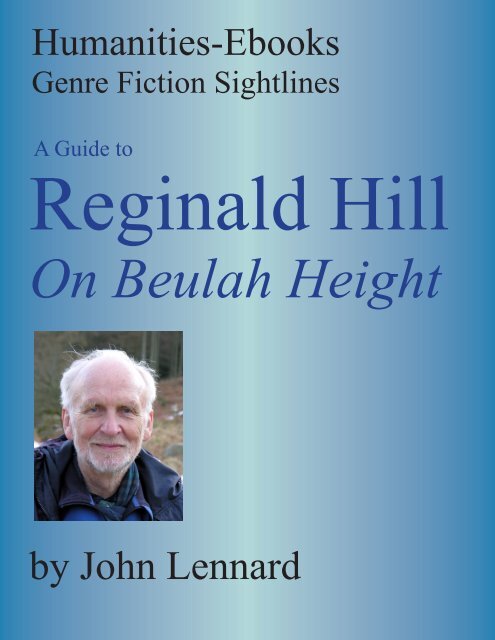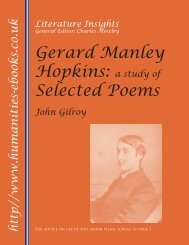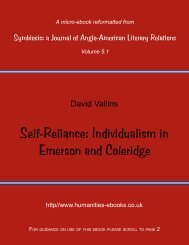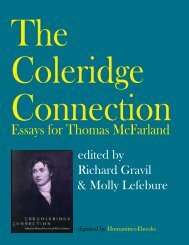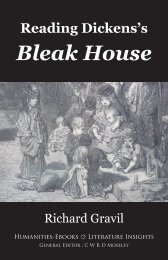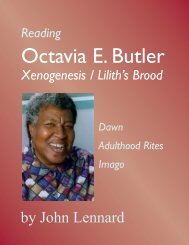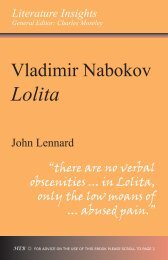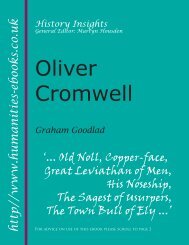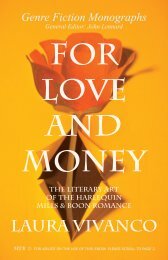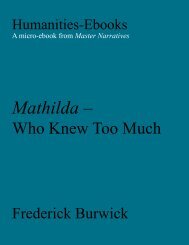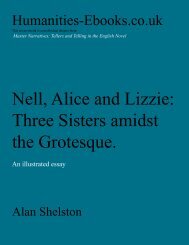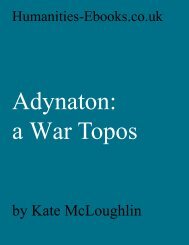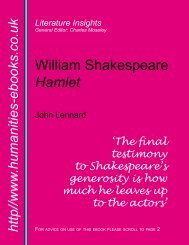On Beulah Height - Humanities-Ebooks
On Beulah Height - Humanities-Ebooks
On Beulah Height - Humanities-Ebooks
Create successful ePaper yourself
Turn your PDF publications into a flip-book with our unique Google optimized e-Paper software.
<strong>Humanities</strong>-<strong>Ebooks</strong><br />
Genre Fiction Sightlines<br />
Running Head 1<br />
A Guide to<br />
Reginald Hill<br />
<strong>On</strong> <strong>Beulah</strong> <strong>Height</strong><br />
by John Lennard
Publication Data<br />
Text © John Lennard, 2007<br />
The Author has asserted his right to be identified as the author of this Work in accordance<br />
with the Copyright, Designs and Patents Act 1988. Copyright in images and in<br />
quotations remains with the sources given. Every effort has been made to trace the<br />
holders of copyright materials. If any have not been traced the author will be glad to<br />
make the necessary arrangements at the first opportunity.<br />
Published in 2007 by <strong>Humanities</strong>-<strong>Ebooks</strong>.co.uk.<br />
Tirril Hall, Tirril, Penrith CA10 2JE<br />
ReaDing oPtions<br />
* To use the navigation tools, the search facility, and other features of the<br />
Adobe toolbar, this Ebook should be read in default view.<br />
* To navigate through the contents use the hyperlinked ‘Bookmarks’ at<br />
the left of the screen.<br />
* To search, expand the search column at the right of the screen or click<br />
on the binocular symbol in the toolbar.<br />
* For ease of reading, use to enlarge the page to full screen<br />
* Use to return to the full menu.<br />
* Hyperlinks appear in Blue Underlined Text.<br />
licence anD PeRmissions<br />
Purchasing this book licenses you to read this work on-screen and to print<br />
one copy for your own use. Copy and paste functions are disabled. No part<br />
of this publication may be otherwise reproduced or transmitted or distributed<br />
without the prior written permission of both the copyright owner and the publisher.<br />
Making or distributing copies of this book constitutes copyright infringement<br />
and would be liable to prosecution. Thank you for respecting the rights<br />
of the author.<br />
isbn 978-1-84760-035-6
Reginald Hill: <strong>On</strong> <strong>Beulah</strong> <strong>Height</strong><br />
John Lennard<br />
Tirril: <strong>Humanities</strong>-<strong>Ebooks</strong>, 2007
A Note on the Author<br />
John Lennard took his B.A. and D.Phil. at Oxford University, and his M.A.<br />
at Washington University in St Louis. He has taught in the Universities of<br />
London, Cambridge, and Notre Dame, and for the Open University, and is<br />
now Professor of British & American Literature at the University of the West<br />
Indies—Mona. His publications include But I Digress: The Exploitation<br />
of Parentheses in English Printed Verse (Clarendon Press, 1991), The<br />
Poetry Handbook (1996; 2/e, OUP, 2005), with Mary Luckhurst The Drama<br />
Handbook (OUP, 2002), and the Literature Insights Hamlet (2007).<br />
He is the general editor of the Genre Fiction Sightlines and Monographs series,<br />
and has written Sightlines on works by Octavia E. Butler, Ian McDonald and<br />
Walter Mosley. His critical collection Of Serial readers and other essays on<br />
genre fiction (2007), published simultaneously with this e-book, launches<br />
the Monographs Series.
Contents<br />
1. Notes<br />
1.1 Reginald Hill<br />
1.2 The Dalziel & Pascoe Series<br />
1.2.1 The Series<br />
1.2.2 The Regular Cast<br />
1.2.3 Mid-Yorkshire and Northern English Speech<br />
1.2.4 TV Adaptations<br />
1.3 Police Ranks in England and Wales<br />
1.4 <strong>Beulah</strong> in the Bible and in Bunyan<br />
1.5 Rückert’s and Mahler’s Kindertotenlieder<br />
1.5.1 Background<br />
1.5.2 The German texts and literal translations<br />
1.6 Thatcherism and Water Privatisation<br />
1.7 Serial Killing and Paedophilia<br />
1.8 Meningococcal Meningitis<br />
2. Annotations<br />
2.1 Epigraphs<br />
2.2 Day <strong>On</strong>e: A Happy Rural Seat of Various View<br />
2.3 Day Two: Nina and the Nix<br />
2.4 Day Three: The Drowning of Dendale<br />
2.5 Day Four: Songs for Dead Children<br />
3. Essay: Singing the Sadness of <strong>On</strong> <strong>Beulah</strong> <strong>Height</strong><br />
4. Bibliography<br />
4.1 Works by Reginald Hill<br />
4.2 Works about Reginald Hill and Crime Writing<br />
4.3 Useful Reference Works
1. Notes<br />
1.1 Reginald Hill<br />
Reginald Charles Hill was born in 1936, in West Hartlepool<br />
in Northern England. His mother, Isabel née Dickson<br />
(1907–98) was a factory worker who loved Golden-Age © Reginald Hill<br />
crime writing, and his father was a professional football (soccer) player at a time<br />
when sportsmen were poorly paid, so his background was very proletarian but<br />
reading was privileged. The family moved to the Lake District in 1939, and Hill<br />
later attended Carlisle Grammar School, from which he won a place to read English<br />
at St Catherine’s College in Oxford. He did National Service without distinction or<br />
danger 1955–7, went up in 1957, graduated in 1960, and immediately married his<br />
childhood sweetheart, Patricia Ruell.<br />
After some odd jobs Hill became a teacher, in Essex (1962–7) and then at<br />
Doncaster College of Further Education, in Yorkshire (1967–81), where he rose to<br />
Senior Lecturer before becoming a full-time writer in 1981. Hill had begun writing<br />
prose fiction in the mid-1960s, and from 1970 published prolifically, producing (to<br />
date) more than 50 novels and collections of short stories under four names. In<br />
addition to the 20 Dalziel & Pascoe novels, Hill writes superior stand-alone crime<br />
and supernatural tales, while ‘Patrick Ruell’ has written eight thrillers, ‘Charles<br />
Underhill’ two historical romances, and ‘Dick Morland’ (in Hill’s early days) two<br />
political thrillers. All the work is enjoyable, and from the mid-1970s increasingly<br />
substantive as well as richly comic and intertextual, so that Hill’s career as a whole<br />
strongly bears out his avowed intention of writing crime novels to high literary<br />
standards.<br />
Since retiring from teaching at 45 Hill has preferred to let his books do the<br />
talking, but he has over the years published a number of critical essays and<br />
introductions that reveal a wise, wry, and thoughtful critic of his chosen genre/s.<br />
There are also some excellent interviews, but Hill is also a wise, wry, and very<br />
elusive interviewee, who sensibly prefers not to analyse himself when others have<br />
such fun doing it for him. He now lives in the Lake District, is a keen fell-walker,<br />
and remains, as he has always been, an avid reader.<br />
6
1.2 The Dalziel and Pascoe Series<br />
1.2.1 The Series<br />
The 20 Dalziel & Pascoe (D.-&-P.) novels are, in order of publication 1 :<br />
A Clubbable Woman (1970).<br />
An Advancement of Learning (1971).<br />
Ruling Passion (1973).<br />
An April Shroud (1975).<br />
A Pinch of Snuff (1978).<br />
A Killing Kindness (1980).<br />
Deadheads (1983).<br />
Exit Lines (1984).<br />
Child’s Play: a tragi-comedy in three acts of violence with a prologue and an<br />
epilogue (1987).<br />
Under World (1988).<br />
Bones and Silence 1990). (CWA Gold Dagger, Best Crime Novel, 1990.)<br />
Recalled to Life (1992).<br />
Pictures of Perfection: A Dalziel and Pascoe novel in five volumes (1994).<br />
The Wood Beyond (1996).<br />
<strong>On</strong> <strong>Beulah</strong> <strong>Height</strong> (1998). (Barry Award, Best Novel, 1999.)<br />
Arms and the Women: an Elliad (2000).<br />
Dialogues of the Dead: or Paronomania! an aged worm for wept royals a warm<br />
doge for top lawyers a word game for two players (2001).<br />
Death’s Jest-Book (2002).<br />
Good Morning, Midnight (2004)<br />
The Death of Dalziel (2007) 2<br />
There is also one D.-&-P. collection, Asking for the Moon (1994), containing two<br />
novellas, ‘Pascoe’s Ghost’ & ‘<strong>On</strong>e Small Step’, and two stories, ‘Dalziel’s Ghost’ &<br />
‘The Last National Serviceman’. There are also seven uncollected D.-&-P. stories<br />
written for newspapers, magazines, and anthologies—‘Auteur Theory’, ‘Where the<br />
Snow Lay Dinted’, ‘A Candle for Christmas’, ‘Brass Monkey’, ‘A Gift for Father<br />
Christmas’, ‘The Game of Dog’, and ‘Fool of Myself’. 3<br />
1 Full details in the Bibliography.<br />
2 Don’t worry! The title’s a tease.<br />
3 The stories have been variously published; full details in the Bibliography.<br />
7
As the staggered dates of publication suggest, Hill did not (before 2001–2) write<br />
consecutive D.-&-P. books, giving him time to consider what he wanted to do with<br />
the series, and the novels have grown steadily more complex and ambitious. From<br />
the beginning they were clever, entertaining, and gave something serious to chew<br />
on. From the mid-1980s they grew exponentially in gravitas and range to encompass<br />
subjects including the Miners’ Strike and its consequences; the ‘Yorkshire Ripper’, a<br />
serial killer of the late 1970s, and his legacy; the activities of the security services,<br />
MI5 and MI6; animal-rights activism; and paedophilia.<br />
The novels are allusive and intertextual, not only in their titles and epigraphs but<br />
in using inset-texts and weaving quotations (some acknowledged, some not) into<br />
dialogue and narrative. They also summon and measure themselves against highcanonical<br />
literature from Shakespeare and Milton to Austen and Dickens, yet rarely<br />
leave the largely realistic and necessarily brutal world of murder and investigation—<br />
a combination from which Hill draws ever-expanding and deepening resonance. He<br />
is also a superb comic writer—and while series novelists have to be comedic, as<br />
their protagonists survive, they are by no means necessarily comic. Hill’s metaphors<br />
for his Unholy Trinity—Dalziel’s fatness & unstoppability, Pascoe’s fastidiousness<br />
& imagination, and Wield’s ugliness & efficiency—are often memorable,<br />
summoning P. G. Wodehouse or Evelyn Waugh as much as any crime writer. And the<br />
combination of wry laughter and open mockery with an unflinching gravitas in<br />
analysing crimes is a major part of Hill’s triumph.<br />
1.2.2 The Regular Cast<br />
The supporting casts vary from novel to novel; the major series players are:<br />
Detective Chief Superintendent Andrew Dalziel (‘Andy’, ‘the Fat Man’), Head<br />
of Mid-Yorkshire Criminal Investigation Department (CID), is of Scottish stock but<br />
a Yorkshireman to the bone. Enormously fat, frequently crude, almost always blunt,<br />
and astonishingly light on his feet, he is a hard drinker very rarely drunk, far more<br />
subtle than most folk guess, and easily mistaken for God. He is long divorced, but in<br />
The Wood Beyond (immediately preceding <strong>On</strong> <strong>Beulah</strong> <strong>Height</strong>) began a relationship<br />
with divorcee Amanda ‘Cap’ Marvell, built on the same lines but of a higher social<br />
class. Cap is also politically radicalised, having nearly lost her soldier-son in the<br />
Falklands War, and the relationship was in trouble as The Wood Beyond ended, but<br />
resumes after a hiatus in <strong>On</strong> <strong>Beulah</strong> <strong>Height</strong>.<br />
8
Detective Chief Inspector Peter Pascoe, once Dalziel’s protégé and now his<br />
deputy, is also of Yorkshire stock (though Pascoe is a Cornish name) but a<br />
Southerner by upbringing. Unlike Dalziel, he is university educated, a fast-track new<br />
breed of less brutal detective, but has recently been enraged and troubled by the<br />
discovery that his great-grandfather, who ‘died in World War <strong>On</strong>e’, had in fact been<br />
executed for ‘cowardice’. Peter is married to Eleanor (Ellie), née Soper, once a<br />
college teacher and still a political activist of sorts on the populist left, but now also<br />
an aspiring novelist and full-time mother of Rose (Rosie).<br />
Detective Sergeant Edgar Wield, the experienced CID organiser, is as<br />
phenomenally ugly as Dalziel is fat, with a near photographic memory. He has a<br />
limited formal education but is very sharp, and has voluntarily stuck at sergeant to<br />
avoid the public exposure of higher rank—because he is also gay, out to his closest<br />
friends and superiors but not openly at work. After various intersections of his<br />
personal and professional lives, in Pictures of Perfection he met Edwin Digweed,<br />
trained as a lawyer but now running an antique book business. Wield and Digweed<br />
now cohabit at Corpse Cottage in the unusually tolerant village of Enscombe (which<br />
Dalziel, appreciating its unreality, tends to call ‘Shangri-La’ or ‘Brigadoon’).<br />
Detective Constable Shirley Novello (‘Ivor’, but only to Dalziel), is the most<br />
recent junior officer to join the Mid-Yorks CID team. She is a twenty-something<br />
Catholic, sturdy and bright but still learning her way.<br />
Chief Constable Dan Trimble (‘Desperate Dan’), the Head of Mid-Yorks Police,<br />
is a Cornishman Dalziel more or less respects, and the only superior to whom he<br />
usually answers.<br />
The four major figures, Dalziel, Peter & Ellie Pascoe, and Wield, have been together<br />
since Wield was introduced in A Pinch of Snuff (1978), but while Hill’s settings have<br />
always remained more-or-less contemporary with publication, his characters have<br />
aged more slowly than real time. Dalziel & Pascoe are in many ways a comic duo,<br />
an ‘odd couple’ like Laurel & Hardy deliberately pairing a fatter, older, more brutal<br />
Northerner with a slimmer, younger, more liberal Southerner; but Dalziel is also<br />
Rosie’s godfather, ‘Uncle Andy’, and adores her. Ellie nurses a liberal left-wing<br />
suspicion of the police, but is caught by her love for Peter and acknowledgement of<br />
his sense of civic obligation in policing, not least as a counter-weight to Dalziel (a<br />
9
heroic, hopeless task). Wield started as necessary underling, a replacement Detective<br />
Sergeant when Pascoe made Inspector, but in coming to terms with his identity as a<br />
gay policeman (and latterly finding contentment with Digweed) has grown into<br />
close personal friendship with the Pascoes.<br />
Some minor characters have also become established presences— solicitor Eden<br />
Thackeray, vicar Larry Lillingstone in Enscombe, idiotic and disaster-prone PC<br />
Hector—but these are tagged or re-explained when they recur.<br />
1.2.3 Mid-Yorkshire and Northern English Speech<br />
All Hill’s D.-&-P. novels are set in the fictional, archetypal ‘Mid-Yorkshire’ (Mid-<br />
Yorks.), an additional imaginary administrative county drawing freely on the land-<br />
and cityscapes of the whole of Yorkshire. Detailed settings—villages like Dendale<br />
and Enscombe—are fictional; real place-names are rarely given, but the industrial<br />
cities of Sheffield and Doncaster (where Hill lived), and the cathedral-city of York,<br />
are often recognisable, as are features of landscape, economy, and demography.<br />
Mid-Yorks., that is, is an archetype, like Hardy’s Wessex or Paul Scott’s Ranpur and<br />
Mirat a blend of typicalities and fictions making a place utterly grounded in the real,<br />
but never restricted to it, or to real-world geography. To understand it, therefore, one<br />
has to know something of the Yorkshire that provides Hill with his raw materials.<br />
A very large traditional county in Northern England, Yorkshire stretches from<br />
Sheffield to Middlesbrough and the Pennines to the East Coast. It covers some 6,000<br />
square miles (15,000 km 2 ), and has a population of roughly 5 million. (See <br />
http://www.yorkshirenet.co.uk/maps/index.asp.) Yorkshire is traditionally divided<br />
into the North, West, and East ‘Ridings’ (or ‘thirds’), reflecting the Vikings’<br />
division of land around the cathedral city of York.<br />
Much of the North Riding is uneven rural land, the Yorkshire Dales in the east<br />
and North York Moors in the west. A ‘dale’ is a valley; most are farmed both for<br />
arable and dairy produce, and they are flanked by ‘fells’, hills used for sheepfarming.<br />
The moors, often boggy, are high and desolate. Administratively the North<br />
Riding is now mostly the county of North Yorkshire.<br />
The East Riding is low farmland, some higher ground (the Yorkshire Wolds),<br />
and a fishing coast, with Hull the only big city. It is still known as the East Riding,<br />
and most is administratively its own county.<br />
The West Riding has been very heavily urbanised and industrialised since the<br />
early nineteenth century, but service and light industries now predominate. The<br />
major cities of Leeds, Bradford, Halifax, Huddersfield, Doncaster (where Hill lived<br />
10
Is this sample what you are looking for?<br />
If so, please browse our lists<br />
or look for different formats at:<br />
http://www.humanities-ebooks.co.uk<br />
or buy this PDF book<br />
HERE<br />
About <strong>Humanities</strong> <strong>Ebooks</strong><br />
<strong>Humanities</strong>-<strong>Ebooks</strong> is an an authors’ co-operative, not a commercial publisher.<br />
Our aim is to produce inexpensive, high quality <strong>Ebooks</strong>, and to pass the maximum<br />
possible proportion of the purchase price to their authors.<br />
Almost all our titles are available in Kindle format, though for academic books<br />
and those with complex layout the PDF is almost invariably superior.<br />
All our titles can be ordered by libaries through Ebrary, EBSCO and MyiLibrary.<br />
Paperback versions of many of our titles can be reached via the book descriptions<br />
on our website.


